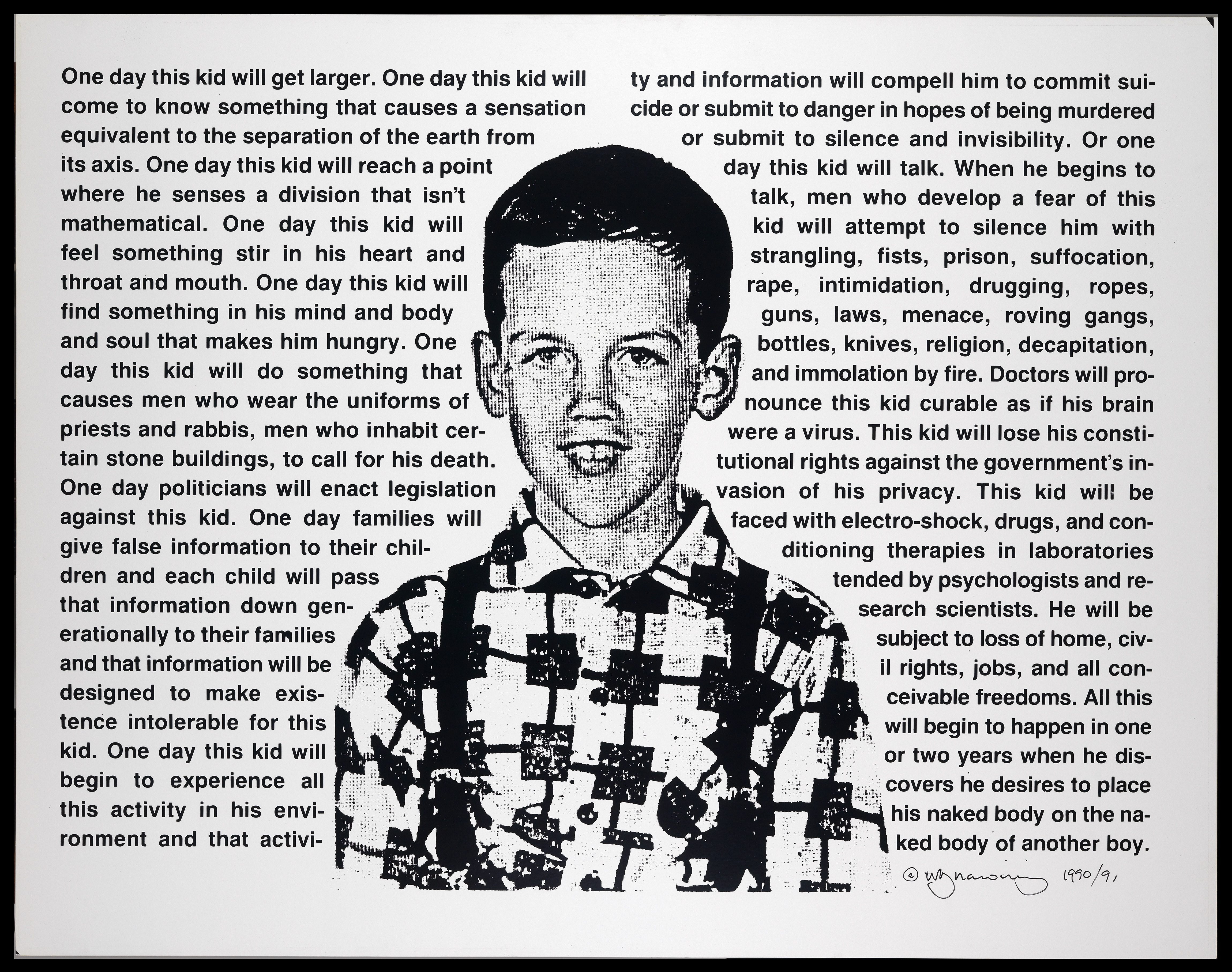Audio by Kate Hanks
Audio by Shanice Bailey
Will be on view in the lower level Summer 2018
Maker: David Wojnarowicz (1954 – 1992)
Culture: American
Title: Untitled (One day this kid…)
Date Made: 1990-1991
Type: Print
Materials: Photostat (Basically a photocopy on special photographic paper)
Place Made: United States
Measurements: 31 x 41 in
Transcripts:
Kate –
The first thing I noticed about this piece is how starkly black and white it is, and how the text is really small in comparison to the image of the boy, which means you have to get really close to it to read the writing, and then the boy seems extra big in comparison. And then once you start reading the words, you get drawn into the story that’s being told. And as it goes, it gets more and more intense, so it first it’s just “one day this kid will get larger” so you think it might just be a story about growing up. But as you go the words shift from talking about the boy to talking about what people are doing to him and all the scary things that are happening to him. And it’s not really until you read the last sentence that you understand why that’s happening. And I don’t think this piece is fully auto-biographical, but it definitely draws on the artist’s personal life. That boy is him as a child and he grew up to be deeply involved in AIDS activism and making art was a big part of that for him. He died a few years after this was made from AIDS. And I think that putting his childhood self in the center of this work is really important because it makes it seem less with a lecture and more personal and intimate. I always leave this piece feeling pretty shaken up and disturbed.
Shanice –
This is an example of the kind of work that got me interested in art and David Wojnarowicz continues to be one of my favorite artists of all time and probably one of the ones whose art is closest to my heart. I think it’s because this piece in particular engages identity in a very visible way, like it’s literally written out for you on the page and also just including the photo of himself as a child feels very vulnerable. Especially as he is someone who as an adult so very much looked like he did as a kid, so when I look at that face I know exactly who it is. And there’s something that’s just very visceral and strong about the way that he writes. When you’re reading the piece when there’s like the list of things, like intimidation, drugging, ropes, guns, laws, menace, roving gangs, and it kind of is like raining down on you. And it situates you in the piece and sort of implicates you too, because you are immediately identifying with this child. And you keep reading because you want to know what happens to him and then the very last line is kind of, like it just feels like, I don’t know, like a punch to the throat almost.
My real entry into art and learning how to appreciate it and the first time I actually loved an object was learning about the AIDS crisis and the activist art and sort of cultural production that came out of that because it was something that I felt like I could strongly relate to. My uncle passed away from AIDS related complications when I was really young, but I was so young that I couldn’t understand the full scope. It was a huge political moment, it was a public health crisis, it was a really generative, creative moment also, even though it was something that was so devastating. My interactions with AIDS art helped me; it really positioned me in the climate of the time and helped me understand the ways that people were feeling that didn’t necessarily get covered in say, like historical accounts of the crisis. And I still think that’s my most enduring connection to art objects and has become the lens through which I see other things. I guess my commitment to objects like that and objects that have something to say and are expressive of voices that wouldn’t otherwise be heard are what keeps me wanting to do that work, and in a desire to uplift those objects and make sure they’re seen and also share them with other people.
